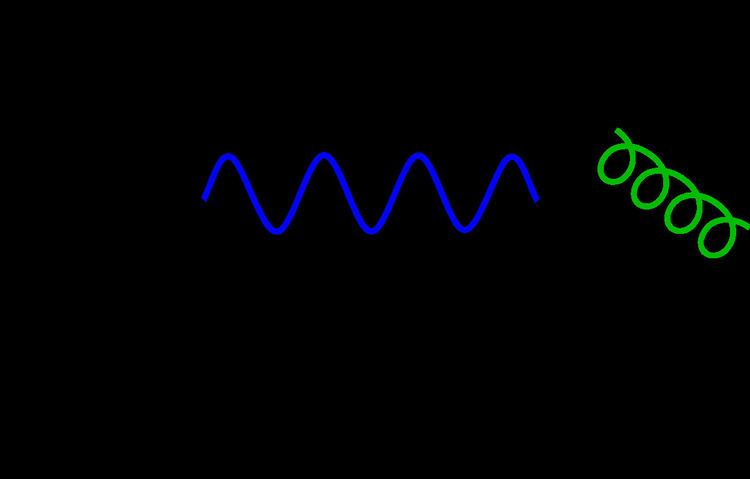 | ||
In physics, Faddeev–Popov ghosts (also called gauge ghosts or ghost fields) are extraneous fields which are introduced into gauge quantum field theories to maintain the consistency of the path integral formulation. They are named after Ludvig Faddeev and Victor Popov.
Contents
- Overcounting in Feynman path integrals
- Ghost condensate
- FaddeevPopov procedure
- Spin statistics relation violated
- Gauge fields and associated ghost fields
- Appearance in Feynman diagrams
- Ghost field Lagrangian
- General ghosts in theoretical physics
- Changing the symmetry
- References
A more general meaning of the word ghost in theoretical physics is also discussed below.
Overcounting in Feynman path integrals
The necessity for Faddeev–Popov ghosts follows from the requirement that quantum field theories yield unambiguous, non-singular solutions. This is not possible in the path integral formulation when a gauge symmetry is present since there is no procedure for selecting among physically equivalent solutions related by gauge transformation. The path integrals overcount field configurations corresponding to the same physical state; the measure of the path integrals contains a factor which does not allow obtaining various results directly from the action.
Ghost condensate
In particle physics, a ghost condensate is a speculative proposal in which a ghost, an excitation of a field with a wrong sign of the kinetic term, acquires a vacuum expectation value. This phenomenon breaks Lorentz invariance spontaneously. Around the new vacuum state, all excitations have a positive norm, and therefore the probabilities are positive definite.
We have a real scalar field φ with the following action
where a and b are positive constants and
using the sign convention in the (+, −, −, −) metric signature.
The theories of ghost condensate predict specific non-Gaussianities of the cosmic microwave background. These theories have been proposed by Nima Arkani-Hamed, Markus Luty, and others.
Unfortunately, this theory allows for superluminal propagation of information in some cases and has no lower bound on its energy. This model doesn't admit a Hamiltonian formulation (the Legendre transform is multi-valued because the momentum function isn't convex) because it is acausal. Quantizing this theory leads to problems.
Faddeev–Popov procedure
It is possible, however, to modify the action, such that methods such as Feynman diagrams will be applicable by adding ghost fields which break the gauge symmetry. The ghost fields do not correspond to any real particles in external states: they appear as virtual particles in Feynman diagrams – or as the absence of gauge configurations. However, they are a necessary computational tool to preserve unitarity.
The exact form or formulation of ghosts is dependent on the particular gauge chosen, although the same physical results must be obtained with all gauges since the gauge one chooses to carry out calculations is an arbitrary choice. The Feynman-'t Hooft gauge is usually the simplest gauge for this purpose, and is assumed for the rest of this article.
Spin-statistics relation violated
The Faddeev–Popov ghosts violate the spin-statistics relation, which is another reason why they are often regarded as "non-physical" particles.
For example, in Yang–Mills theories (such as quantum chromodynamics) the ghosts are complex scalar fields (spin 0), but they anti-commute (like fermions).
In general, anti-commuting ghosts are associated with fermionic symmetries, while commuting ghosts are associated with bosonic symmetries.
Gauge fields and associated ghost fields
Every gauge field has an associated ghost, and where the gauge field acquires a mass via the Higgs mechanism, the associated ghost field acquires the same mass (in the Feynman-'t Hooft gauge only, not true for other gauges).
Appearance in Feynman diagrams
In Feynman diagrams the ghosts appear as closed loops wholly composed of 3-vertices, attached to the rest of the diagram via a gauge particle at each 3-vertex. Their contribution to the S-matrix is exactly cancelled (in the Feynman-'t Hooft gauge) by a contribution from a similar loop of gauge particles with only 3-vertex couplings or gauge attachments to the rest of the diagram. (A loop of gauge particles not wholly composed of 3-vertex couplings is not cancelled by ghosts.) The opposite sign of the contribution of the ghost and gauge loops is due to them having opposite fermionic/bosonic natures. (Closed fermion loops have an extra −1 associated with them; bosonic loops don't.)
Ghost field Lagrangian
The Lagrangian for the ghost fields
The first term is a kinetic term like for regular complex scalar fields, and the second term describes the interaction with the gauge fields. Note that in abelian gauge theories (such as quantum electrodynamics) the ghosts do not have any effect since
General ghosts in theoretical physics
The Faddeev–Popov ghosts are sometimes referred to as "good ghosts". The "bad ghosts" represent another, more general meaning of the word "ghost" in theoretical physics: states of negative norm—or fields with the wrong sign of the kinetic term, such as Pauli–Villars ghosts—whose existence allows the probabilities to be negative thus violating unitarity.
Changing the symmetry
Ghost particles could obtain the symmetry or break it in gauge fields. The "good ghost" particles actually obtain the symmetry by unchanging the "gauge fixing lagrangian" in a gauge transformation, while bad ghost particles break the symmetry by bringing in the non-abelian G-matrix which does change the symmetry, and this was the main reason to introduce the Gauge covariant and contravariant derivatives.
